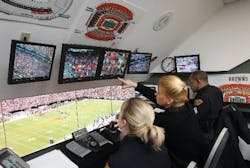Four Ways Technology Can Make Cities Safer
Pundits have long debated the root causes of crime and how to combat it, such as investing in education, early intervention, and programs to reduce unemployment. Those may be successful strategies from a social perspective, but what about technology? Can technology also be a safe-city enabler?
Here are four ways that cites can apply technology to enhance safety:
Leverage Existing Security Systems to their Fullest Potential – Let’s face it, government agencies already invest a lot of money in security systems, ranging from street video surveillance to access control, license plate recognition (LPR), gunshot detection and other systems. Some of these systems are used by private organizations as well. So collectively, in a city, county or region, there is already a well-established and powerful security system infrastructure.
Most times, the only thing lacking is the ability to connect it all together. But that’s changing. For example, Cleveland’s Shared Security Surveillance (CS3) program has been lauded for keeping “C-Town” safe. The initiative, which started as a small pilot program, has grown by leaps and bounds, with public and private cameras all tied into the City’s Public Safety network, and more expansion planned. The video is a force multiplier and crime solver. It has even been credited with helping to lower crime rates.
PSIM offers one way to achieve this more easily. An open, overlay, vendor-agnostic solution, PSIM can combine any number of video management systems (VMSs) in one user interface. Control room operators just see the big picture. They never even know that there are different brands of VMS working behind the scenes.
Unify and Correlate Security Information – Building on my last point, to the extent that different city agencies/entities invest in all of these security systems, why not centralize all of them in one place? And I don’t mean physically. What I do mean is having all of the information and alerts from these systems come into one centralized place – and what better place than the city control center?
I’m not just talking sharing video feeds although that’s a big part of it. By feeding other sensors into the command center, a city can create a tight security net around the city. Think DoT video cameras, radiological sensors on the transit system, the access control system at a nuclear power plant, a perimeter protection system for a city water supply, a university’s campus emergency notification system.
Now, if there’s a major accident on the highway, a terrorist incident, a campus shooting, a breach at a critical facility, the control center has the immediate real-time situational awareness they need to respond. Also because all of the information coming from these different city-wide (or regional) sources is now part of one system, it can be cross-correlated. Is what just happened on campus connected to this other event?
Leveraging video for smarter investigations – Another big challenge cities have is piecing together forensic evidence in the aftermath of an incident. Here I’m not just talking about surveillance video, but police in-car video and cell phone video too. Today, through the aid of specialized technology, it’s possible to take all of these different types of video and combine them into one seamless incident timeline, along with first responder and 9-1-1 voice recordings and other multimedia. When assembled together as part of a complete picture, this information can provide extraordinary insight for investigators as to how an event unfolded.
Social media as the ultimate crime fighting tool – Cities are also creatively employing social media as an effective crime fighting tool. For example, the Philadelphia Police Department leverages Twitter, Facebook, and YouTube as part of a comprehensive social media and community engagement program. Videos and information about various unsolved crimes are posted on these social media sites.
Citizens view the information and then submit tips via text messages, email, or phone. Since its inception in 2011, the program has resulted in well over 100 arrests. It’s another great example of how innovative technology, applied the right way, can make cities safer.
I’ll be exploring some of these trends at the upcoming Secured Cities conference on November 14-15 in Baltimore as part of a panel titled “Safe City: How Cleveland Gets It Done.” Joining me on the panel will be: Larry Jones II, Project Manager for the City of Cleveland Department of Public Safety Office of Information Technology and Tony Sereda, an executive with Real Time Crime Centers Global Solution Sales, Motorola Solutions.
About the Author:
Diamond Chaflawee is director of marketing & business development for NICE System’s Public Safety sector.
About Secured Cities Conference:
Secured Cities is the only conference in the industry that serves the public/private partnership initiatives that are driving emerging video surveillance, hosted and cloud-based security solutions, and integrated risk strategies across every enterprise.
This unique venue offers a peer-to-peer experience with ranking participants from government, law enforcement, transit, campus and healthcare, in addition to high-level security management from, both the physical and IT sides of the house.
Secured Cities has taken a leadership position in reaching the major stakeholders in the urban security landscape; increasing their understanding of changing funding and grant initiatives, emerging technologies, management and operations, best practices and peer-led applications.
Secured Cities is not a trade show but rather a solutions summit. The event’s content-driven focus attracts decision-makers. High-end attendees at Secured Cities are those asking the ‘why’ questions, versus the ‘what,’ meaning they have a specific need and are looking for companies that provide solutions and peer interaction that offers a roadmap for success.
The Secured Cities two-day conference gets straight to the point, promoting discussions and offering solutions to challenges facing today’s security industry.
To register for Secured Cities, please follow this link: https://www.xpressreg.net/esite/index.php?show=SCMD113
